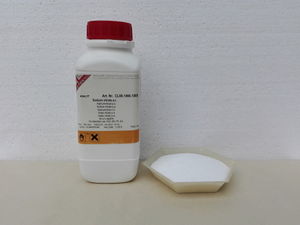Sodium nitrate
 Sodium nitrate sample and original bottle
| |
| Names | |
|---|---|
| IUPAC name
Sodium nitrate
| |
| Other names
Chilean saltpeter
Cubic niter Peru saltpeter Soda niter | |
| Properties | |
| NaNO3 | |
| Molar mass | 84.9947 g/mol |
| Appearance | White solid |
| Odor | Odorless |
| Density | 2.257 g/cm3 |
| Melting point | 308 °C (586 °F; 581 K) (decomposition begins) |
| Boiling point | Decomposes |
| 73 g/100 ml (0 °C) 91.2 g/100 ml (25 °C) 180 g/100 ml (100 °C) | |
| Solubility | Very soluble in ammonia, hydrazine Soluble in ethanol, methanol Slightly soluble in pyridine Insoluble in acetone |
| Vapor pressure | ~0 mmHg |
| Thermochemistry | |
| Std molar
entropy (S |
116 J·mol-1·K-1 |
| Std enthalpy of
formation (ΔfH |
−467 kJ/mol |
| Hazards | |
| Safety data sheet | Sigma-Aldrich |
| Lethal dose or concentration (LD, LC): | |
| LD50 (Median dose)
|
3,236 mg/kg |
| Related compounds | |
| Related compounds
|
Lithium nitrate Potassium nitrate |
| Except where otherwise noted, data are given for materials in their standard state (at 25 °C [77 °F], 100 kPa). | |
| Infobox references | |
Sodium nitrate (also known as Chilean saltpeter) is a sodium salt with the chemical formula NaNO3.
Contents
Properties
Chemical
Sodium nitrate decomposes in the presence of a metal to yield sodium nitrite:
- 2 NaNO3 → 2 NaNO2 + O2
Reaction with sulfuric acid produces nitric acid:
- NaNO3 + H2SO4 → HNO3 + NaHSO4
- 2 NaNO3 + H2SO4 → 2 HNO3 + Na2SO4
Potassium nitrate, typically more desired as an oxidizer than sodium nitrate, can be produced in a somewhat impure form by cooling a hot saturated solution containing the proper molar amounts of both sodium nitrate and potassium sulfate. Because sodium sulfate is much less soluble than potassium nitrate, most of it will crystallize out of solution fairly quickly.
Physical
Sodium nitrate is a white solid which is very soluble in water. Unlike its potassium counterpart, sodium nitrate is hygroscopic. It's soluble in methanol, ethanol, ammonia, and hydrazine, but not in acetone.
Availability
Sodium nitrate is sold as a meat curing salt and food additive, sometimes in pharmacies. It can also be bought in larger quantities as fertilizers, which are often impure. Sodium nitrate is cheaper to produce than buy in places with easy access to ammonium nitrate.
Preparation
Sodium nitrate is prepared industrially by neutralizing nitric acid with sodium carbonate or sodium bicarbonate.
- 2 HNO3 + Na2CO3 → 2 NaNO3 + H2O + CO2
- HNO3 + NaHCO3 → NaNO3 + H2O + CO2
An easier route involves mixing a solution of sodium hydroxide and ammonium nitrate, which can be made even easier with the use of sodium bicarbonate or carbonate:
- NH4NO3 + NaOH → NaNO3 + NH4OH
- NH4NO3 + NaHCO3 → NaNO3 + NH3 + H2O + CO2 (Requires heating in solution to complete)
- 2 NH4NO3 + Na2CO3 → 2 NaNO3 + 2 NH3 + H2O + CO2 (Requires heating in solution to complete)
Since ammonium hydroxide will quickly decompose in the basic conditions to release ammonia, the solution will contain fairly pure sodium nitrate, though heating may be required to finish decomposing it:
- NH4OH → NH3 + H2O
This reaction should be performed outside or in a fume hood. The reaction is self-sustaining and proceeds very quickly with wet sodium hydroxide and more slowly in dry conditions, but with the carbonate or bicarbonate is easily controlled and requires a long period of boiling of the solution.
Projects
- Making sodium nitrite
- Poor man's aqua regia
- Smoke bombs
- Make nitric acid
- Meat curing (food grade NaNO3 only!)
Handling
Safety
Sodium nitrate is not very toxic, and as long as it is not consumed it's safe to handle. Medical studies indicate that long-term consumption increases the risk of several illnesses, such as stomach cancer, diabetes mellitus and Alzheimer.
Because it's hygroscopic, sodium nitrate is a poor oxidizer unless kept completely dry, through much effort, until it is used.
Storage
Sodium nitrate should be stored in closed containers, due to its hygroscopicity.
Disposal
Sodium nitrate doesn't require special disposal, although it's best to avoid releasing it in the environment due to its sodium ions.